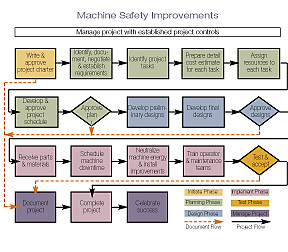The major phases of a lockout/tagout-machine guarding project would include: initiation, planning, design, implementation, testing and acceptance, documentation and project controls. Let’s examine each.

1) Initiation
The project initiation phase will start you down the correct path. The intent is to describe the project at a high level, including the project deliverables and the threshold that must be met for deliverables to be accepted. For example, compliance with your state’s Administrative Code XYZ would be the deliverable for this project. The acceptance criteria could be the identification of the team that will approve the final work. A rough order of magnitude cost estimate should also be provided with a general project completion date in mind — say the end of the year when the new regulations are effective.
This information can be documented in a charter document and approved by the appropriate parties, such as the project sponsor, finance director, safety officer and project manager. This charter will establish credence for and initiate the project.
2) Planning
Projects that are planned well produce better, more economical results. One of the most difficult tasks when planning a project is identifying, documenting, negotiating and establishing the requirements. This project’s requirements should identify the applicable codes and list equipment that requires lockout/tagout compliance and also equipment that would require machine guarding. Approved requirements are the foundation for a successful project.Once the requirements are established the various project tasks must be identified and put in a logical sequence. For instance, a guard must be designed prior to fabrication or procurement. A detail estimate, including labor and non-labor amounts for each task, should be made. Each task must be assigned to a resource that is responsible for its completion with that resource’s availability in mind. At that point a detailed project schedule can be developed. This project plan should have each piece of equipment and its associated tasks identified on the project schedule.
You may have thought the detail schedule would be the first thing generated when you were tasked with bringing your plant into lockout/tagout and machine guarding compliance. But putting together a good, viable plan that includes the detail schedule is first required.
3) Design
Once the applicable codes and equipment lists have been completed, the design for each piece of equipment can start. The design effort should include pertinent items such as:
- Identification of all machine energy sources (including gravity);
- Proper labeling for machine energy sources;
- A documented method to neutralize all energy sources;
- Machine placards that show the operator and maintenance personnel where the energy sources are and how to neutralize them;
- Machine guard designs;
- Notices for the computer maintenance management that will identify lockout/tagout and machine guarding notices so the equipment will be properly handled and checked for compliance during maintenance procedures;
- Bills of material or purchase requisitions to obtain lockout/tagout supplies, machine guarding parts or entire guards;
- Documentation and approval of the lockout/tagout procedure to be used by your company;
- Training for all affected employees;
- A process to assure the lockout/tagout and machine guarding information is accurate in the future such as updating when equipment is relocated;
- Test and acceptance plan.
4) Implementation
The implementation of your project should go well if the project plan and design phases were comprehensive and accurate. Some of the prime items to consider during implementation are:
- Receive and store the parts until they can be scheduled for fabrication or installation.
- Schedule machine downtime with your manufacturing organization.
- Properly neutralize power and install lockout/tagout labels and placards.
- Properly neutralize power and install machine guards.
- Train machine operators on the proper use of the equipment with the new guards in place.
- Train the maintenance team on the lockout/tagout procedure, labels and placards.
5) Testing and acceptance
Once the lockout/tagout labels, placards and machine guards are installed the machines should be tested and accepted for design compliance and safety. Ideally, the testers should be a third party not involved in the design and installation of the safety devices. Pictures of the safety improvements should be taken to document the test results.6) Documentation
The following project documentation should be filed for future reference and possible use: project charter; lockout/tagout placard artwork; machine guard designs; bills of material or purchase requisitions; maintenance instructions; test and acceptance results; pictures of equipment; training rosters.7) Project controls
Instilling project controls will ensure that the project provides what the customer requested on time and within budget. Project controls include:
